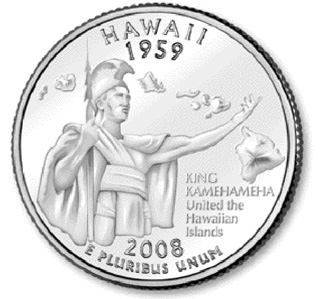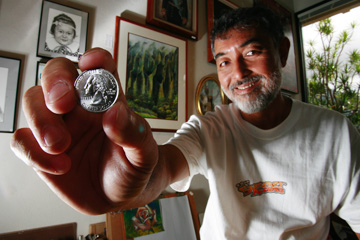 | ||||||||||||
|
|
Takazono admits he might have had an edge. He's a professional artist (portraits, landscapes) and, more than that, in the past he designed some coins for a Hawaii mint. "I worked up sketches for lots of designs and actually drew up a dozen or so before settling on King Kamehameha," said Takazono. "All sorts of Hawaii icons, like Diamond Head, hula girls, nene, surfing. I read up and asked opinions. Iolani Palace, for example, sounds good, but as a design, it's boring." In the end he went with gut instinct. "The representation of Kamehameha in the statue is an icon of Hawaii. It's not only a natural, it has real power, a reference that people can accept on the obverse side of a coin from Washington. I tried a full-length drawing of the statue, but that was needlessly complicated, and added the map of the Hawaii Islands because we're the only state that actually IS an island." That's right, Rhode Island does have islands, but it's mostly wedged like spackle between Connecticutt and Massachusetts. And Rhode Island dares to call itself the "Ocean State." Like, whatever. "We're only one in 50, so I had to consider the whole context of the state and come up with the strongest design I could," said Takazono. Department of Education spokesperson Greg Knudsen set an example by doing his homework. His uncluttered design of a hula dancer and Diamond Head struck a chord with voters, enough for a second-place finish. "I've been following quarter designs since they started and collect them too," said Knudsen. "I though we needed something to represent our unique culture, something that when a person on the mainland who pulls out a quarter in the dead of winter, it makes them dream of going to Hawaii." Knudsen said he was inspired by images of real hula dancers, not iconic kitsch hula. "Of course the mint will have the final say -- and how will they react to an image of a king on the other side of a coin featuring Washington?" wondered Knudsen.
"I researched and researched, and the palace is the most prominent thing in Hawaiian history," said Chung, a retired printer with a keen sense of graphics."
"I'm looking at them right now!" said Johnson by phone. "What's fascinating about people's submissions is that, if you go back into history and look at coins that were minted in the islands, thay all had similar designs and subjects. There are just certain iconic elements of life in Hawaii that create visual standards." The lone exception, said Johnson -- the "shaka" sign. All these commisions can do is suggest a theme to the US Mint. Today is the deadline for submitting a theme. Go to www.hawaii.gov/gov/commemorativequarter and register your wishes on either the Web site, by e-mail or by fax. There's a space to explain your selection, a kind of 50-word essay. "I'm a little disappointed that our coin commision doesn't allow attachment of sketches on the e-mails. Other states did!" noted Knudsen. The site lists criteria for themes, including appropriate designs -- state landmarks (natural and manmade), landscapes, historically significant buildings, symbols of state resources or industries, official state flora and fauna, state icons or the outline of the state -- as well as designs that are inappropriate, such as the "state flag, the state seal, head-and-shoulders portrait or bust of any person, living or dead, controversial subjects or symbols that are likely to offend or logos or depictions of specific commercial, private, educational, civic, religious, sports, or other organizations whose membership or ownership is not universal." Got that? There's another opportunity for putting your coinage where your mouth is at a public hearing May 17 at the Hawaii Convention Center.
© Honolulu Star-Bulletin -- https://archives.starbulletin.com
| Tools
| ||||||||||
 | ||||||||||||




